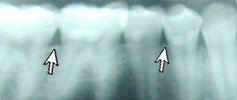Gum Disease
What is gum disease?
According to the American Dental Association, at least 60% of adults in the United States have moderate-to-severe gum disease! No doubt, you’ve heard some of the terms: Plaque, Tartar, Calculus, Gingivitis, Periodontitis, Pyorrhea, Periodontal Disease, Gum Disease. But what does it all mean? Quite simply, Gum Disease (Periodontal Disease) starts when plaque and tartar (calculus) are allowed to accumulate at the base of your teeth. The bacteria in the plaque leads to an infection in the gums (gingiva) called Gingivitis. Left untreated, the infection spreads to the tissue and bone that holds your teeth in place, a condition called Periodontitis (Pyorrhea). Because of the bacterial infection associated with Periodontitis, tooth abscesses are also common.

Gum Disease Is preventable
Gum disease is a serious condition that can lead to tooth loss and other health problems. The early stage of gum disease, known as gingivitis, is characterized by red, swollen gums that bleed easily. If left untreated, gingivitis can progress to periodontitis, a more severe form of gum disease that can destroy the bone and connective tissue that support the teeth. In addition to causing tooth loss, gum disease has been linked to an increased risk of heart disease, stroke, and other medical conditions. Gum disease is preventable with good oral hygiene and regular dental checkups. If you are experiencing symptoms of gum disease, be sure to see your dentist as soon as possible for treatment.
What are the Signs of Gum Disease?
Gum Disease is rarely painful, especially in the early stages. Although there may be no visible signs, some of the common indications of Gum Disease are:
- Gums that bleed when you brush or floss (healthy gums will not bleed)
- Gums that are red, swollen, or tender
- Gums that have pulled away from the teeth (receded)
- Pus (infection) between the teeth and gums
- Loose permanent teeth or separating (drifting) teeth
- Changes in the way your teeth fit together when chewing
- Persistent bad breath

This patient has Periodontitis. Notice the bone deterioration and uneven level of bone.

Healthy gums and bone.
Gum Care is Very Important
Gum disease, also known as periodontal disease, is a condition in which the gums and bones around the teeth become infected. Periodontal disease is caused by plaque, a sticky film of bacteria that constantly forms on the teeth. If plaque is not removed, it can harden into tartar, which can lead to inflammation of the gums. Left untreated, this inflammation can damage the bone and connective tissue that support the teeth, eventually leading to tooth loss. Gum disease is also a risk factor for other health problems such as heart disease and stroke. Therefore, it is important to remove plaque from your teeth every day through brushing and flossing, and to see your dentist regularly for professional cleanings. By taking these steps, you can help prevent gum disease and keep your smile healthy for years to come.

Book your appointment!
Start your journey to a healthy smile today.
